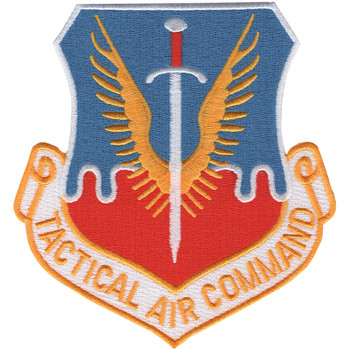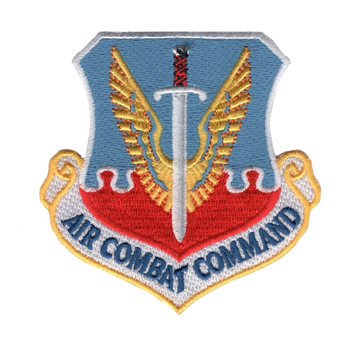Description
Tactical Air Command Patch (U.S. Air Force) 3" x 3" Embroidered Patch with Iron-On Backing
Superior Materials: Made with premium polyester thread and durable twill fabric, ensuring long-lasting color and strength.
Advanced Embroidery Technology: Crafted using the most advanced embroidery machinery, guaranteeing intricate detail, sharp lines, and consistent quality every time.
Easy Iron-On Application: Features a heat-activated adhesive backing for quick, no-sew attachment. Simply position, iron, and press for a secure bond.
Versatile Use: Perfect for personalizing jackets, backpacks, uniforms, or any fabric surface that needs a touch of personality.
Durable and Washable: Designed to withstand everyday wear and occasional washing without fading or fraying.
Formations & Origins
The Tactical Air Command (TAC) was a major command of the United States Air Force (USAF) responsible for providing tactical air support for ground forces, conducting combat operations, and ensuring air superiority during times of conflict. TAC was established in 1946, following the end of World War II, as a result of the need for a centralized command to oversee air operations that supported ground and naval forces. The command's primary mission was to develop and employ tactical aviation to achieve air dominance and provide close air support to ground troops. Over the years, TAC played a vital role in numerous conflicts and was instrumental in the development of modern air combat tactics and doctrine. The Tactical Air Command patch, with its bold and dynamic design, symbolizes the versatile and aggressive nature of the command's mission.
Notable Commanders
TAC was led by several influential commanders during its long and storied history. One of the most prominent was General Laurence S. Kuter, who served as the command’s first commander and set the tone for its rapid development post-WWII. Kuter’s leadership helped shape TAC into the capable and powerful force that it would become, especially during the Cold War.
Another notable figure was General John D. Ryan, who took command of TAC during the Vietnam War. Under his leadership, TAC was heavily involved in the air campaigns over Vietnam, with aircraft from the command performing close air support, interdiction, and strategic bombing missions. General Ryan was key in developing tactics and strategies that would go on to influence air combat in future conflicts.
Major Campaigns/Operations
TAC played a pivotal role in many major military campaigns during its existence. Some of the most significant include:
-
Korean War: TAC provided essential air support for U.N. forces during the Korean War. Its aircraft performed a variety of missions, including interdiction of enemy supply lines, close air support for ground troops, and air superiority operations. Tactical fighter jets, bombers, and reconnaissance planes were key in keeping pressure on North Korean and Chinese forces.
-
Vietnam War: TAC was heavily involved in the air war in Vietnam, where its aircraft flew thousands of combat sorties, performing roles such as close air support, interdiction, and bombing missions. Fighter jets like the F-4 Phantom and F-105 Thunderchief became symbols of the air campaign, while TAC’s bombers and tactical reconnaissance planes helped gather intelligence and strike key enemy positions. The command's adaptability was crucial in overcoming challenges posed by the dense jungle terrain, anti-aircraft systems, and evolving tactics of the North Vietnamese.
-
Cold War Operations: During the Cold War, TAC was central to NATO’s defense strategy in Europe, maintaining a strong air presence to deter Soviet aggression. TAC aircraft were constantly on alert, ready to defend Western Europe and conduct counteroffensive operations if needed. The command also participated in various NATO exercises and operations designed to keep the pressure on the Soviet bloc.
-
Operation Desert Storm: In the Gulf War of 1990-1991, TAC’s role evolved into more precision-based and high-tech combat operations. The command's aircraft provided close air support for ground troops, as well as strategic bombing against Iraq’s military infrastructure. The use of advanced weapons and precision-guided munitions became the hallmark of TAC’s operations during the conflict.
Specialized Role/Equipment
TAC’s role was defined by its specialized use of tactical aviation, which focused on providing air superiority, close air support, interdiction, and reconnaissance for ground forces. The command was responsible for overseeing a wide variety of aircraft, each tailored for specific roles. Some of the most important aircraft used by TAC included:
-
Fighter Aircraft: Aircraft like the F-4 Phantom, F-105 Thunderchief, and F-15 Eagle were the backbone of TAC's operations. These planes provided air superiority, engaged enemy aircraft, and performed ground attack missions. Their versatility made them integral to nearly every operation TAC was involved in.
-
Close Air Support Aircraft: Aircraft such as the A-10 Thunderbolt, known as the "Warthog," became synonymous with close air support. These aircraft were designed to provide low-altitude, high-impact support for ground troops by targeting enemy armor and infantry with powerful, precision-guided weapons.
-
Bombers: TAC also oversaw tactical bombers, such as the B-52 Stratofortress, which was capable of delivering both conventional and nuclear payloads. These aircraft were used for strategic bombing campaigns during conflicts like the Vietnam War and the Gulf War.
-
Reconnaissance Aircraft: Aircraft like the RF-4C Phantom were specialized in reconnaissance, providing critical intelligence for battlefield commanders. The ability to gather real-time data on enemy positions and movements was vital to the success of TAC operations.
TAC also embraced technological advances throughout its existence, incorporating the latest radar, communications, and weapons systems into its aircraft. This constant innovation allowed the command to maintain air superiority and effectively support ground operations.
Acts of Heroism
Throughout TAC’s history, its pilots and aircrews have demonstrated extraordinary courage and heroism in the face of enemy fire and danger. One notable act of heroism came during the Vietnam War, where pilots from TAC displayed exceptional bravery during Operation Rolling Thunder and Operation Linebacker. The intense anti-aircraft defenses and surface-to-air missile sites in North Vietnam made each mission incredibly dangerous, but TAC pilots continued to fly, knowing the risks, to provide vital support to ground forces.
In particular, the exploits of A-10 pilots during the Gulf War highlighted the courage and tenacity of TAC’s personnel. The A-10’s close air support role in providing protection to ground troops in the face of enemy fire was critical, and many pilots performed missions under heavy fire, saving countless lives on the ground.
Additionally, during the Korean War, a number of TAC pilots received the Medal of Honor and Distinguished Flying Cross for their valor in combat, showing the level of heroism the command's personnel routinely displayed in harrowing combat situations.
Legacy & Notable Achievements
TAC’s legacy is one of pioneering air tactics, shaping the role of tactical aviation in modern warfare. The command’s success in the Korean and Vietnam Wars set the foundation for many of the air combat doctrines still used today. TAC was instrumental in the development of close air support as a critical component of modern combat, and its aircraft became synonymous with air dominance and battlefield support.
In the 1990s, TAC’s role evolved as new technologies such as precision-guided munitions, stealth aircraft, and advanced radar systems transformed the way air forces operated. The command’s integration of these technologies in the Gulf War demonstrated the effectiveness of modern, precision-based warfare.
One of TAC’s most notable achievements was its ability to support joint operations, working seamlessly with the Army, Marines, and NATO allies. Its ability to adapt to the ever-changing needs of modern warfare and to provide crucial air support on a global scale ensured that TAC remained a pillar of the U.S. Air Force for decades.
In 1992, Tactical Air Command was merged with the Strategic Air Command and the Military Airlift Command to form the Air Combat Command (ACC), but its legacy lives on through the ACC and the continued evolution of tactical air operations. The TAC patch remains a proud symbol of the command’s history and the remarkable service of its personnel, marking them as one of the most impactful air forces in history.


















